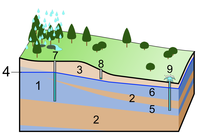
Photo from wikipedia
In this study, laboratory experiments were combined with numerical modeling to study the water quality variation and hydrogeochemical evolution of recharged water during the aquifer groundwater recharge (AGR). Reclaimed water… Click to show full abstract
In this study, laboratory experiments were combined with numerical modeling to study the water quality variation and hydrogeochemical evolution of recharged water during the aquifer groundwater recharge (AGR). Reclaimed water from wastewater treatment plant (WWTP) was recharged into a one-dimensional column filled with field sediments. The chemical reactions, soil-soluble species dispersion, mineral dissolution and precipitation, adsorption, and cation exchange in the recharge aquifer zone were examined. The study showed that the pH of the system varied from 6.31 to 7.77 during the 159-h experiment process. Mineral dissolution and cation exchange were dominant for Al, Zn, and Fe, and absorption caused As and Se to always tend toward 0 during leaching. Dissolution caused total nitrogen and dissolved organic carbon to form additional contaminants in the preliminary stage. The 3-D excitation/emission matrix spectra illustrated the humus in sediments were a potential threat to the groundwater quality by leaching. By fitting the major ions like Na+, Ca2+, Cl−, and HCO3− using PHREEQC soft, we developed a solute transport model and used them to predict the hydrogeochemical evolution under different migration lengths. Through the analysis for pH, ionic strength, and hardness index, we think that at the initial time, the effluent after transporting 25 m accorded with the standard of class I water quality index of groundwater. The study can be used to provide theoretical foundation and lead the field practice.
Journal Title: Arabian Journal of Geosciences
Year Published: 2018
Link to full text (if available)
Share on Social Media: Sign Up to like & get
recommendations!